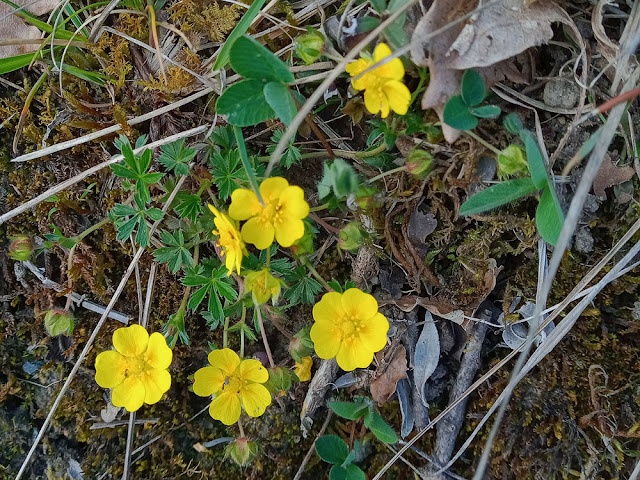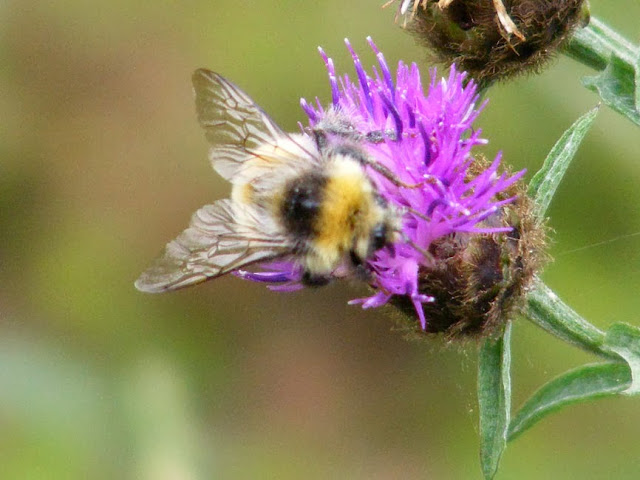Wild flower mixes are often nothing of the sort. They are frequently just a mix of seeds for annual plants which germinate easily and have pretty coloured flowers. Pollinators won't entirely spurn them, but they are not what the insects are really interested in. If you want to really attract pollinators you need to encourage dandelions, thistles and wild carrot (if it makes you feel better, call wild carrot 'Queen Anne's Lace'). And the real pollinators are not just honey bees. Flies and wild bees are even more important.
 |
| Dandelion Taraxacum sp. |
Recent studies show that there about 35 plants in Europe that are key to attracting a wide range of about 500 species of wild bees, both generalists and specialist feeders. Some of them, such as Cornflower Centauraea cyanus and Brown Knapweed C. jacea can be abundant in the wild and are often included in commercial wild flower mixes. But others, such as Stiff Hedgenettle Stachys recta and Musk Thistle Carduus nutans are either not abundant in the wild, or, conversely, regarded as a weed, and are not included in typical wild flower mixes.
 |
| Cornflower Centaurea cyanus in a canola crop. |
Modern agricultural landscapes are notoriously short on plants that will provide a suitable range of food for pollinating insects, who generally prefer semi-natural habitats. Whilst honey bees are important for pollinating certain crops through sheer numbers, they are often not the most efficient operators and don't offer the best crop yields. We need wild bees too. Well run farms are maintaining semi-natural flower rich grassland, and establishing new strips of such habitat, but unfortunately the flower mixes they are sowing are often only suitable for generalist species of pollinators. For best success you need a flower mix that contains species that flower successively in April/May, then are followed in June by a second group of species, and finally, some species that flower in July/August.
 |
| Western Honey Bee Apis mellifera on Vipers Bugloss Echium vulgare. |
The plants that have the richest load of pollen are dandelions Taraxacum spp (visited by 7 out of 8 bee species), Charlock Mustard Sinapis arvensis, Spear Thistle Cirsium vulgare, hawkweeds Hieracium spp and White Clover Trifolium repens. Viper's Bugloss Echium vulgare is the most important species for supporting both rare Red-listed species and abundant generalist species.
 |
| Female Fabricius's Nomad Bee Nomada fabriciana on dandelion Taraxacum sp. |
However, of the 35 important species, known in pollinator research cirles as 'high visitor richness plant species', fewer than half are present in commercial mixtures, and only 9 of them are present in most mixes. A recent study revealed that 13 of the important species were not found in any commercial mix. The important plant species most likely to be included in a commercial pollinator mix are Cornflower, Brown Knapweed, Golden Marguerite Anthemis tinctoria, Tansy Tanacetum vulgare and Vipers Bugloss.
 |
| Buff-tailed Bumble Bee Bombus terrestris on Red Clover Trifolium pratense. |
A good seed mix should contain 40 or more species of herbaceous plants and be capable of supporting over 200 species of wild bees. Poor seed mixes are those with fewer species of plants (there are some available with a count as low as a mere 10 species). A recent study highlighted the importance of Spotted Knapweed Centaurea stoebe, Stiff Hedgenettle, Vipers Bugloss, Black Horehound Ballota nigra, Spring Cinquefoil Potentilla verna and Wintercress Barbarea vulgaris as 'high visitor richness' plant species.
 |
| Spring Cinquefoil Potentilla verna. |
Spring Cinquefoil and Wintercress are particularly important early in the season, when not much is available. Flowering trees and bushes, which produce huge amounts of pollen, are also tremendously important at this time of year. Knapweeds and Stiff Hedgenettle flower all summer and typically see the highest numbers of bees visit them (which makes sense, as this is the period of peak bee activity). Vipers Bugloss and Black Horehound flower from late spring to late summer and provide great continuity through the changing seasons.
 |
| Male pale form White-tailed Bumble Bee Bombus lucorum, nectaring on Common Knapweed Centaurea jacea. |
Pollen sources are far more important than nectar sources for bees, as it is pollen that gets fed to the next generation when they are larvae. For this reason Canola Brassica napus and Birdsfoot Trefoil Lotus corniculatus can form a useful part of the seed mix, as they are used by certain bee species and provide significant pollen.
 |
| Buff-tailed Bumble Bees Bombus terrestris on Wild Oregano Origanum vulgare, plus a photo bombing Southern White Admiral butterfly. |
The flowers that suit bees are not necessarily the same as those that attract other pollinators such as hover flies. You may also want to include some species that have lower pollenator value, but are attractive to seed eating birds. Whilst both bees and hover flies visit Oregano Origanum vulgare and Greater Knapweed Centaurea scabiosa, plants such as Ladys Bedstraw Galium verum, Common Agrimony Agrimonia eupatoria and umbellifers Apiaceae are not so attractive to bees even though hover flies happily use them. Wild flower mixes should take into consideration their function other than for bee pollinators, including as habitat for parasites which can be useful in the control of insect pest species, and how attractive the mix is to herbivores.
 |
| Female wool carder bee Anthidium sp on Field Scabious Knautia arvensis. |
In general terms the most important plant families to include in your wild flower mix are daisies Asteraceae (eg hawkweeds, dandelions, oxtongues, knapweeds), peas Fabaceae (eg vetches), mustards Brassicaceae and mints Lamiaceae (eg hedgenettles). If you want to get fancy and attract some of the rarer species of bees then include Birdsfoot Trefoil, Smooth Hawksbeard Crepis capillaris, Red Clover Trifolium pratense, Common Chicory Cichorium intybus, Creeping Thistle Cirsium arvense, Wild Carrot Daucus carota, and Small Scabious Scabiosa columbaria, as well as some bell flowers Campanula spp.
 |
| Hawkweed Hieracium sp. |
If you are sowing a wild flower strip for wild bees, don't forget to provide or protect some habitat for them to nest in -- so a sandy bank or a good bee hotel. From a practical point of view, seeds of some of the recommended plants, such as Musk Thistle and Black Horehound, are not available from even specialist seed suppliers. On the other hand, Cornflower and Knapweed seeds are regularly included in even the most commercial of mixes, and Vipers Bugloss, Meadow Clary Salvia pratensis, Oregano, Charlock Mustard and Wintercress seeds are available from certain specialist seed producers.
 |
| Rampion Bellflower Campanula rapunculus, with sleeping bee, possibly Chelostoma sp. |
As far as possible seeds should come from locally sourced stocks, although in France this is not easy or straightforward. You may have to resort to forming partnerships with local organic farms and collecting seed yourself. Treat non-native plants with suspicion, even when they are highly attractive to the local insect population. Canadian Goldenrod Solidago canadensis is a good example to avoid as you don't know how it will disrupt the native natural plant and insect interactions. Some species, like dandelions, do not need to be added to wild flower mixes because they occur naturally so widely and abundantly. Just remember to let them flower! Some species, such as Musk Thistle, are difficult to manage and undesirable for other reasons. You may wish to avoid others, such as brassicas, because they interfere with your crops for production or rotation. And like all these sorts of conservation measures, the practice is experimental until you establish what works best for your conditions.
 |
| Male parasitic fly Ectophasia crassipennis on Wild Carrot Daucus carota. This species is common in late summer. It parasitizes bugs such as stink bugs, shield bugs and leaf-footed bugs. |
So your take away should be that commercial wild flower mixes are rubbish, and at the very least you should be combining several to get a decent range of species. If the commercial mix you've picked up contains cosmos or Californian poppy, just put it back on the shelf. Ideally you should be encouraging species that are probably already growing on your land such as knapweeds, dandelions, thistles, wild mints (oregano, black horehound, meadow clary, hedgenettles), Vipers Bugloss, wild mustards, clovers and hawkweeds. Augment commercial mixes with any of the plants I've mentioned here. The bees will thank you.

2 comments:
I'm not so unhappy about my selection of plants here, now. One of the best for the wild bees here is the White Clover.... they go berzerk over it!! I think I must do a proper census of what I have in the meadow this year.
I have done cursory ones, but I think a weekly walk is needed.... it'll do me good too. The leg wounds allowing [but I think they are shrinking...] I ought to include the grasses in that, too.....
Interesting that you didn't mention chicory which abounds here...
Le Pré de la Forge: Chicory is mentioned in paragraph 10.
Post a Comment